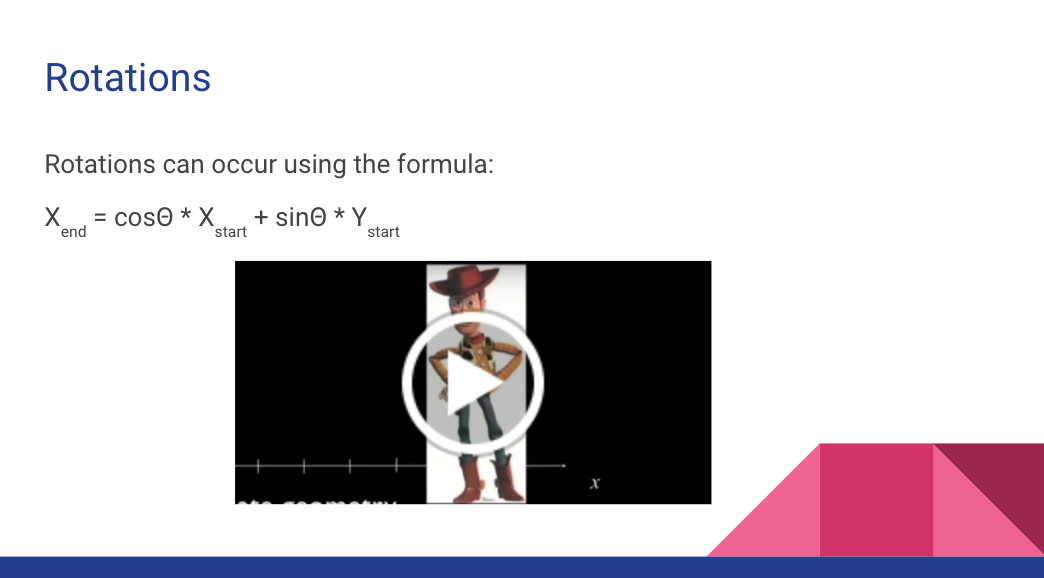Did you know that sound can be expressed as a sine wave? I did not know either before this year, when the 455 Precalculus teachers chose to explore a new opportunity to engage students in the course: group projects. During the projects, students teamed up with classmates in groups of 2-4 (and sometimes individually) to research and develop an understanding of an application of trigonometric ideas in the real world. Eventually, there was a group learning aspect as students presented their projects to the class. According to the assignment, which was given to me by math teacher Mila Martynovsky, “the only requirement is that the project should be closely connected to their everyday lives, hobbies, interests, or aspirations.”
Across the class, each group had the opportunity to make their own topic or pick from a provided list. The examples of topics on the list were trigonometry and architecture, sailing and trigonometry, trigonometry in animation, astronomy and trigonometry, trigonometry in aircraft navigation, and trigonometry in art.
My personal experience preparing my presentation was extremely unique and rewarding. My topic, trigonometry in animation, was something that I was drawn to because I had always wondered how animated characters in film worked. My group and I worked together to understand and process the material we were going to present, which sometimes required us to ask hard questions and take our time. By the day of our presentation, we had prepared a slideshow explaining the various geometric and trigonometric transformations used to animate a Pixar movie. There is always precalculus and calculus in effect behind a character’s position, angle, shape or setting.
I had the opportunity to interview students from Martynovsky’s classes about their experiences working on the projects. Hannah Mayerfield (V) was enthusiastic about particle physics and chose to present on it individually. “I chose that topic because it was something I already knew a lot about, but I learned a lot more about the graphical side of things, which is an aspect of it that I’d never really focused on before. This project was unique because of the complete lack of guidelines or restrictions, which gave me the freedom to do whatever I wanted with the material I researched.”
Mayerfield also emphasized how much she learned from the other groups. “I learned a lot from other presentations, especially from the animation section of Trigonometry in Art– it was interesting hearing about the mathematical models used for Computer Generated Imagery (CGI).”
Nate Abrams (V) also steered away from the initial list of topics and presented on trigonometry in sports. “I learned how trigonometry applied in sports and with this, I was able to apply it to how I play soccer. The project was unique because I never recognized how the math I learn in school applies to me in real life. The research process was unique because it required lots of self reflection,” he remarked.
Marisa Warman Hirschfield (V) agreed that her presentation connects to her life and the spaces she finds herself in. Her group studied music and trigonometry. “My group studied everything from the sound of a sine wave to noise canceling headphones. I was especially interested in applications, in looking at how math is naturally intertwined with everything we do. Trigonometry, I found, is really essential to constructing concert halls, and the David Geffen Hall (at Lincoln Center) renovation is a really great example. It’s currently undergoing $550 million worth of changes – just to improve the acoustics. Computer scientists, acousticians, and architects are all working together to analyze how sound reflects off balconies, seats, and other obstacles in the space. I think it’s just wild. $550 million for sound, and math has been absolutely paramount throughout the process.”
Hirschfield also described her experience listening to other presentations. “Each group really did a deep dive into their respective topics. All the presentations were so thorough, and it was inspiring to see how passionate everyone was in sharing what they had learned.”
Theo Chalker (V) shared this sentiment with Hirschfield. “Listening to the presentations was equally as educational as making one. The broad range of topics represented the many ways in which trigonometry can be seen in everyday life. Whether it is through music, animation, or architecture, each and every one of us interacts with trigonometry several times on a daily basis.”
Chalker presented on trigonometry and astronomy. He discussed his group’s unique approach to the project. “My group and I took a more historical approach in creating our presentation. Rather than looking at current day uses of trigonometry in astronomy, we looked to the Ancient Greek and Egyptian mathematicians that first developed trigonometry and applied it to astronomy. Looking at trigonometry in this way helped me understand that even though it may make it easier, you don’t need some fancy computer to calculate complex distances or masses, you just need your mind and a pencil.”
“This project was unique in that it allowed me to view a topic that I am somewhat familiar with and have interacted with it for years in a strictly mathematical manner. Now I can’t look at stars without thinking about how I might find the distance or speed of them!” Chalker added.
Overall, these presentations were a great success. Martynovsky was often left speechless as the students wrapped up their work. It was definitely a great addition to the first semester curriculum and an experience that has given me and my peers great insight into math and the real world!






